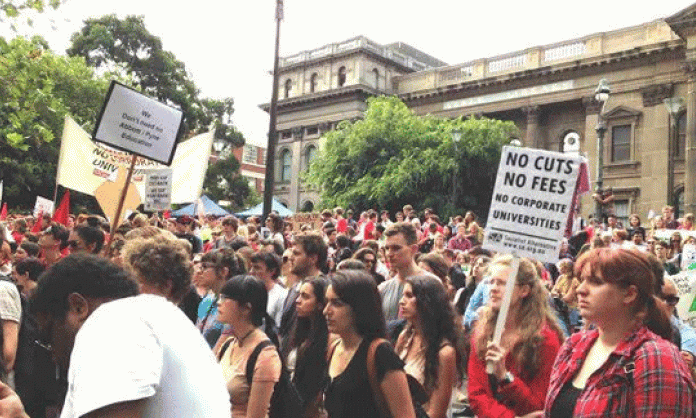This time last year, the Labor government was preparing a federal budget with $2.3 billion worth of funding cuts to higher education.
This time round, as budget day approaches, the Coalition not only remains committed to the cuts but is also indicating that there will be many more attacks on students.
A recent speech by education minister Christopher Pyne, “Freeing universities to compete in a global education market”, set out precisely how the government views education.
“Education policy is, in many ways, economic policy”, he said. “There are enormous spinoff benefits for our domestic economy – in travel, housing, retail and investment … [W]e have expanded education to become our fourth-largest export industry after iron ore, coal and gold.”
For Pyne and the Liberals, there’s no real difference between students and minerals. Both are a source of profit; any red tape strangling its extraction must be removed. They want to find ways to both cut government funding and transfer costs to individual students.
Deregulating fees
The government recently commissioned a review of the “demand driven system” (the current semi-deregulated system) which found that while privatisation is increasing the profitability of education, it hasn’t gone nearly far enough.
The review – conducted by former Liberal federal education minister David Kemp and his closest adviser Andrew Norton – recommends the introduction of a 10 percent loan fee on HECS. It also recommends that HECS support be lowered in general and that HELP support for most postgraduate degrees be removed.
When HECS was first introduced 25 years ago, students repaid a flat fee of $5,400. Today, most students graduate with a debt upwards of $20,000.
This debt is a deterrent for many working class people, especially when coupled with cost of living increases and attacks on student welfare. Today two-thirds of students live below the poverty line.
There are also indications that the government will go further in deregulating and raising fees than recommended in the review.
The vice-chancellors from the richest universities, the Group of Eight (Go8), recently proposed an opt-out system that would allow universities to forego government funding for some courses and charge full fees.
Such a move would amount to the wholesale privatisation of courses and would lead to fee increases of up to 56 percent.
Entrenching a two-tier system
For the Go8 universities, full fees are an opportunity to further distance themselves from the poorer universities and their working class students.
They have the agreement of the education minister. “My view is that … several of our universities [must be] ranked among the very best in the world. The others are thriving in other ways”, said Pyne.
The “other ways” appear to be savage course cuts, staff cuts and, in the case of La Trobe University in Melbourne this year, the abolition of whole faculties. The “demand-driven system” introduced by Labor has already resulted in less competitive universities cutting costs and running down their institutions.
This trend was furthered by the announcement of the $2.3 billion in federal funding cuts and will be accelerated by the introduction of an unregulated fee system: a market mechanism to encourage poorer students to “choose” cheaper degrees at less resourced institutions.
Added to this, Pyne has enthusiastically endorsed another recommendation from the Kemp-Norton review: that private and non-university institutions be incorporated into the Commonwealth scheme. This will mean something very different for Bond University than it will for the majority of TAFEs.
In pursuit of this two-tier system, Pyne is openly drawing inspiration from the notorious US education system. Quoting Adelaide University vice chancellor Warren Bebbington, he said, “[Australia] could have the rich variety of the US university landscape where nearly half of all students … attend teaching-only undergraduate colleges offering only Bachelor degrees … Students have an unforgettable, utterly life-changing educational experience.”
This about a country with an enormous gulf between Ivy League colleges and community colleges; where hundreds of thousands of graduates from community colleges are working for the minimum wage or nothing at all; where only 61 percent of students are able to go to the college of their choice; where students are frequently turned away from study because private companies refuse to extend loans to them; and where student debt has recently surpassed US$1 trillion.
Students need to resist
While working class students will be most disadvantaged by deregulation, the reality is that raising fees and further reducing government funding will affect all students.
The main beneficiaries will be students from wealthy backgrounds and the bank balances of the large institutions.
Students from sandstone universities, 1970s brown brick universities, and corrugated iron/plastic pastiche universities and TAFEs need to work together to fight these attacks.
The government has made it clear that the axe will fall on budget day. Students need to respond immediately.
[The National Union of Students has called demonstrations in every major city for Wednesday 21 May and will be organising protest actions across campuses in the lead-up to those demonstrations. For more information contact your student union or education action group or the National Union of Students.]









